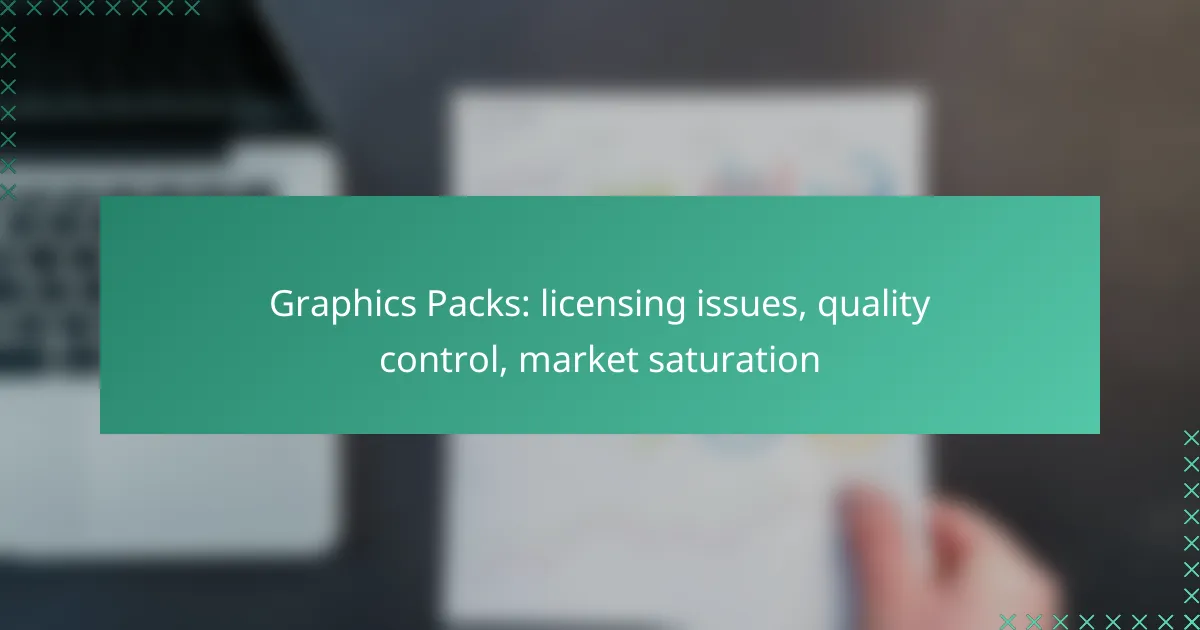The graphics pack industry faces significant challenges, including licensing issues that require a thorough understanding of legal frameworks to avoid disputes. Additionally, implementing robust quality control measures is crucial for ensuring that products meet user expectations and industry standards. To navigate market saturation, businesses must differentiate their offerings by targeting specific niches and embracing innovative design trends.

How to navigate licensing issues in graphics packs?
Navigating licensing issues in graphics packs involves understanding the legal frameworks that govern the use of visual assets. Properly managing these licenses ensures compliance and protects against potential legal disputes.
Understanding copyright laws
Copyright laws protect original works, including graphics and designs, from unauthorized use. In most jurisdictions, the creator of a graphic automatically holds the copyright, which grants them exclusive rights to reproduce, distribute, and display their work.
It’s crucial to recognize that copyright laws vary by country. For instance, in the United States, copyright lasts for the life of the creator plus 70 years, while in some European countries, the duration may differ slightly. Familiarizing yourself with local laws can help avoid infringement.
Types of licenses available
Graphics packs typically come with various types of licenses, each dictating how the assets can be used. Common license types include royalty-free, rights-managed, and creative commons licenses.
- Royalty-free: Allows users to pay a one-time fee for unlimited use without ongoing royalties.
- Rights-managed: Requires users to pay based on specific usage, such as duration and distribution.
- Creative Commons: Offers flexible licensing options, often allowing free use with certain conditions, such as attribution.
Best practices for compliance
To ensure compliance with licensing agreements, always read the terms and conditions associated with each graphics pack. Keep a record of licenses and usage rights for each asset to avoid accidental misuse.
Additionally, when in doubt, consider consulting with a legal expert specializing in intellectual property. This can help clarify any uncertainties and provide guidance on best practices for using graphics legally.

What quality control measures should be implemented?
Implementing effective quality control measures is essential for maintaining high standards in graphics packs. These measures help ensure that the products meet user expectations and industry standards, ultimately leading to greater customer satisfaction and loyalty.
Establishing quality benchmarks
Quality benchmarks are specific criteria that graphics packs must meet to be considered acceptable. These benchmarks can include resolution, file size, compatibility with various software, and adherence to design principles. Establishing clear benchmarks helps streamline the evaluation process and ensures consistency across all products.
For example, a benchmark for resolution might specify a minimum of 300 DPI for print graphics, while digital graphics could require at least 72 DPI. Regularly reviewing and updating these benchmarks is crucial as technology and user expectations evolve.
Tools for quality assessment
Utilizing the right tools for quality assessment can significantly enhance the evaluation process. Software solutions like Adobe Creative Cloud or specialized graphic design tools can help assess color accuracy, resolution, and overall design quality. Automated tools can also assist in checking for common issues such as pixelation or incorrect file formats.
In addition to software, consider implementing checklists that cover essential quality aspects. This can help ensure that all graphics packs undergo a thorough review before release, minimizing the risk of errors.
Feedback loops with users
Creating feedback loops with users is vital for continuous improvement in graphics packs. Engaging with users through surveys, forums, or direct communication can provide valuable insights into their experiences and expectations. This feedback can inform future updates and enhancements to the graphics packs.
Encouraging users to report issues or suggest improvements can foster a sense of community and loyalty. Regularly analyzing this feedback and implementing changes can lead to higher quality products that better meet market demands.

How to address market saturation in graphics packs?
To tackle market saturation in graphics packs, focus on differentiating your offerings by targeting specific niches, embracing innovative design trends, and conducting thorough competitive analysis. This approach helps to carve out unique market segments and maintain relevance in a crowded field.
Identifying niche markets
Identifying niche markets involves researching specific audiences that are underserved by existing graphics packs. Look for unique themes, styles, or applications that cater to particular industries or demographics, such as gaming, education, or social media marketing.
Utilize tools like Google Trends and social media analytics to uncover emerging interests and gaps in the market. For instance, creating graphics packs tailored for eco-friendly brands or local businesses can attract dedicated customers.
Innovative design trends
Staying ahead of innovative design trends is crucial for standing out in a saturated market. Regularly review design platforms, industry blogs, and social media to spot trends such as minimalism, retro aesthetics, or 3D elements that resonate with current consumer preferences.
Incorporating these trends into your graphics packs can enhance their appeal. For example, a pack featuring vibrant, retro-inspired graphics might attract designers looking for nostalgic elements, while a minimalist pack could appeal to modern brands seeking simplicity.
Competitive analysis strategies
Effective competitive analysis strategies involve studying your competitors’ offerings, pricing, and marketing tactics. Identify their strengths and weaknesses to find opportunities for differentiation. Tools like SEMrush or Ahrefs can help analyze competitors’ online presence and keyword strategies.
Consider creating a comparison table that outlines features, pricing, and customer feedback for your graphics packs versus competitors. This can help you identify unique selling points and areas for improvement, ensuring your products stand out in the marketplace.

What criteria should be used for selecting graphics packs?
When selecting graphics packs, focus on design quality, licensing terms, and pricing models. These criteria ensure that the graphics meet your project needs, comply with legal requirements, and fit within your budget.
Evaluating design quality
Design quality is crucial as it directly impacts the visual appeal of your project. Look for packs that showcase high-resolution images, consistent styles, and versatility across different applications. Checking user reviews and sample previews can provide insights into the overall quality.
Consider whether the graphics are suitable for your intended use, whether it’s for digital marketing, web design, or print. A good practice is to assess how well the graphics align with your brand’s aesthetic and message.
Assessing licensing terms
Licensing terms dictate how you can use the graphics, making this a vital criterion. Ensure that the license allows for your intended use, whether commercial or personal, and check for any restrictions on distribution or modification. Common licenses include royalty-free and rights-managed, each with different implications.
Be cautious of hidden fees or limitations that may arise later. A clear understanding of the licensing terms can prevent legal issues and additional costs down the line.
Comparing pricing models
Pricing models for graphics packs can vary widely, from one-time purchases to subscription services. One-time purchases may seem cost-effective initially, but subscriptions can provide access to a broader range of assets over time. Evaluate which model aligns best with your budget and project needs.
When comparing prices, consider the number of assets included and any additional fees for updates or extended licenses. Setting a budget and sticking to it can help you avoid overspending while still obtaining quality graphics.

How do emerging trends impact graphics packs?
Emerging trends significantly influence graphics packs by shaping their quality, accessibility, and market dynamics. As technologies evolve, the demand for high-quality, unique graphics increases, while consumer preferences shift towards more personalized and diverse options.
Influence of AI-generated graphics
AI-generated graphics are transforming the landscape of graphics packs by enabling rapid creation of high-quality assets. This technology allows designers to produce unique visuals at a fraction of the traditional time and cost, leading to a surge in available graphics. However, the challenge lies in maintaining originality and avoiding oversaturation in the market.
As AI tools become more prevalent, it’s crucial for creators to differentiate their offerings. Incorporating human creativity and unique styles can help in standing out amidst a growing pool of AI-generated content.
Shifts in consumer preferences
Consumer preferences are shifting towards more customizable and niche graphics packs. Users increasingly seek assets that cater to specific themes or styles, rather than generic options. This trend encourages creators to focus on developing specialized packs that meet the unique needs of different audiences.
To align with these preferences, designers should consider conducting market research to identify trending themes and styles. Engaging with communities on platforms like social media can provide insights into what consumers are looking for in graphics packs.
Future of digital asset marketplaces
The future of digital asset marketplaces is likely to be shaped by increased competition and innovation. As more creators enter the market, platforms will need to enhance their features to attract both sellers and buyers. This could include improved search functionalities, better licensing options, and user-friendly interfaces.
Marketplaces may also see a rise in subscription models, allowing users to access a broader range of assets for a fixed monthly fee. Creators should stay informed about these trends to effectively position their graphics packs and maximize their reach in a competitive environment.
